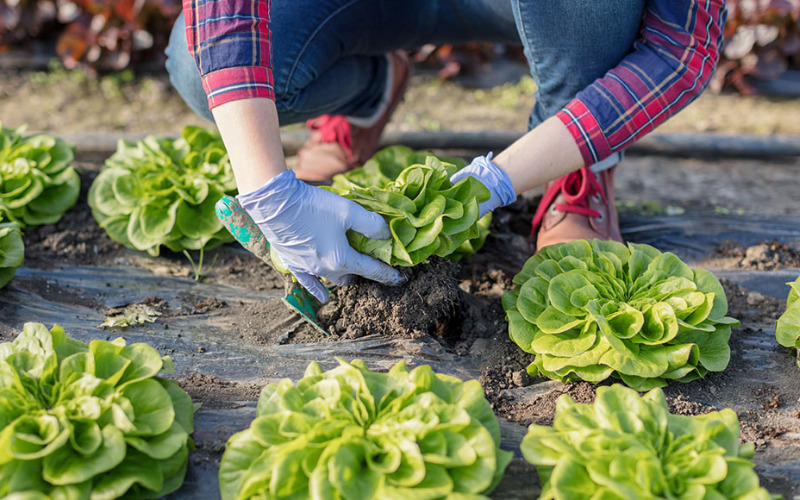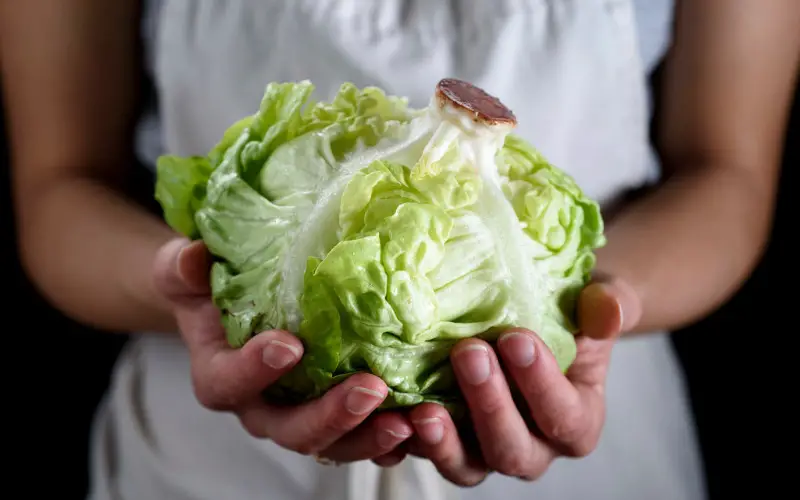There are many reasons you could be interested in growing your lettuce, and one of the reasons may be that you are a huge fan of salads or you want to cut back some money on buying lettuce.
This article reveals how to plant a head of lettuce. Unlike a leaf, a head is a full bunch of lettuce that looks like a cabbage head.
This article reveals how to properly plant and care for lettuce and problems relating to pests and diseases you may face while growing this vegetable.
Can You Plant a Head of Lettuce?
Head lettuce is big and packed with lettuce leaves making it unsuitable for planting. A head of lettuce cannot be planted; however, you can grow fresh stems alone.
Growing this vegetable using the stem entirely differs from the normal planting method of using the seeds.
Head lettuce is the most popular type, and the preferred method of planting this variety is by using seedlings as you get more leaves with little seedlings.
How To Plant Lettuce

Before planting lettuce, you must prepare the seeds’ soil. Rocks, stones, and other heavy materials should be removed as they inhibit the growth of the small seeds.
The depth of the seeds should range from ⅛ to ¼ inches, and since the leaves of this plant will be much, they should be spaced at least 16 inches from each other.
Each row should be spaced between 12 to 15 inches apart, but this spacing may differ for different varieties of this plant.
You can plant chives or garlic between your lettuces to control pests as their smell repels them. You can also plant new seeds every two weeks for a continuous harvest.
Growth Requirements For Lettuce
Providing this plant with the requirements will make it grow earlier and produce more; when it comes to head lettuce, you get more leaves.
1. Water Requirements
Supplying water to this plant will only improve the growth of the roots, and with lettuce, leaf growth is prioritized over the roots. This plant should only be supplied with water to keep it moist, so all you need is light and constant watering.
2. Temperature
An ideal environment for lettuce is one with a cool climate, so you should grow this vegetable at a temperature ranging from 60 to 80°F (15.5 to 26.6°C). Full or intense sunlight is also unnecessary for this plant as it doesn’t provide the best growth environment.
3. pH
Lettuce thrives on soil that is slightly acidic or neutral (6.0 to 7.0). If your soil doesn’t meet this requirement, add some lime to increase the acidity or neutralize it completely. If your soil is too acidic, add some baking soda to increase the pH.
4. Soil Requirements
A soil that provides this plant with the essential nutrients (nitrogen, phosphorus, and potassium) is needed. Fertilizers are vital for this plant. You can decide between organic matter or inorganic fertilizer; at the growing stage, you will need light fertilizers.
How To Harvest Lettuce
Your lettuce is ready to be harvested when its leaves are full, green, soft, and tender. A constant check will be required to ensure that your lettuce doesn’t grow past this stage; when this vegetable grows past this stage, it becomes woody and bitter.
A pre-harvest can be done for the mature outer leaves to allow the inner leaves to develop quickly. All you need to do is gently remove the leaves to avoid serious damage.
You can cut out the outer leaves, dig up the whole plant, or cut it off a few inches above the soil surface for a complete harvest.
Lettuce Pests And Diseases
This section covers some common pests and diseases of lettuce, symptoms, and ways to control them. If you have pests on your lettuce farm, you can apply the control methods suggested in this section to eliminate them.
| Pests | Symptoms | Control |
| Aphids |
|
|
| Earwigs |
|
|
| Powdery mildew |
|
|
| White flies |
|
|
| Slugs and snails |
|
|
| Cutworms |
|
|
| Lettuce mosaic virus |
|
|
| White molds |
|
|
Conclusion
Planting and growing lettuce in your yard or garden are easy. You can choose to grow any variety of this plant, but the most popular variety is the head lettuce which produces a lot of leaves.
We have discussed the best way to plant this variety by using seeds and how they can be planted properly. This article also provides information regarding this plant’s growth requirements and harvesting.
The pest and diseases of this plant can be easily controlled when treated early; fortunately, you can use various homemade solutions to get rid of them.
Helpful Links:
- Tips for Growing Lavender in Florida
- Can You Dethatch St. Augustine Grass?
- 30 Amazing Flowers That Start With B
- How to Grow Yellow Daisies in Your Garden
- What Causes White Spots On Tomato Leaves?
- How to Grow Brussel Sprouts in Containers At Home
We trust this article helped you understand how best to plant lettuce. You may also want to check out How To Propagate Monstera Adansonii.
Thanks for taking the time to read our article, and we hope you find it helpful. Would you mind leaving a comment below if you have any suggestions?
Kindly reach out to people by sharing this post on social media.
If you liked this article, then please follow us on Facebook, Instagram, Twitter, and Pinterest.

